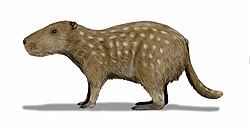| Cephalomys Temporal range: | |
|---|---|
| Scientific classification | |
| Domain: | Eukaryota |
| Kingdom: | Animalia |
| Phylum: | Chordata |
| Class: | Mammalia |
| Order: | Rodentia |
| Family: | † Cephalomyidae |
| Genus: | † Cephalomys Ameghino, 1897 |
| Synonyms [1] | |
| |
Cephalomys is an extinct genus of rodent that inhabited South America during the Oligocene and Miocene epochs.














